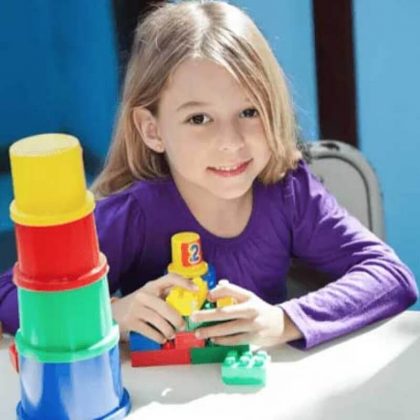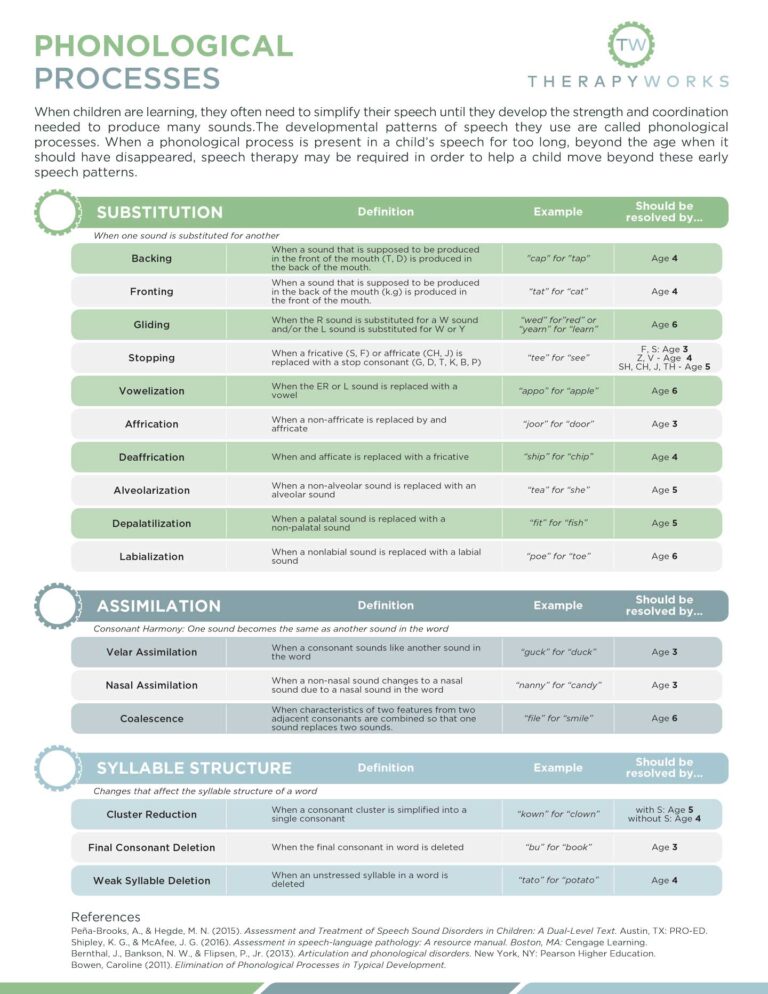What are phonological processes?
Phonological processes are the ways that young children change or simplify the sounds in words as they learn to talk. These processes are a normal part of language development and help children produce speech sounds that are easier for them to say. For example, a child may simplify the word “stop” to “top” by dropping the “s” sound, or replace the “th” sound in “think” with the “f” sound, producing “fink.” These changes are temporary and typically disappear as children get older and their speech becomes clearer.
Understanding phonological processes can help parents better understand their child’s speech development and know what to expect as their child grows and becomes a more confident and clear communicator.
Here are some common phonological processes that occur in children’s language development, along with brief explanations and the ages they typically resolve. Phonological Processes fall under three categories: syllable structure, substitution, and assimilation (downloadable chart below).
Syllable Structure
Sound changes that cause sounds or syllables to be reduced, omitted or repeated
- Cluster Reduction occurs when a child simplifies a cluster of consonant sounds into a single sound or a more manageable combination of sounds.(e.g. “poon” for “spoon”, “tuck” for “truck”). This phonological process should resolve by the time a child is 4 for words without /S/ and by age 5 for words with /S/.
- Final Consonant Deletion is the deletion of a final consonant sound in a word (e.g. “cuh” for “cup”, “dah” for “dog”). We can expect this sounds pattern to resolve by the age of 3.
- Initial Consonant Deletion is the deletion of the initial consonant sound in a word (e.g. “up” for “cup”, “un” for “sun”). This is an unusual pattern that typically indicates the presence of a phonological delay. If your child is using this phonological process, we recommend reaching out to a speech language pathologist for a consultation.
- Weak Syllable Deletion is the deletion of a weak syllable in a word (e.g. “nana” for “banana”, “puter” for “computer”). This process resolves by the age of 4.
Substitution
When one sound is substituted for another.
- Backing is the substitution of a sound produced in front of the mouth with a sound produced in the back of the mouth (e.g. “gog” for “dog”). Typically, children who are backing their sounds will require speech therapy. This is an unusual phonological process that often necessitates the help of a speech-language pathologist.
- Fronting is the substitution of a sound produced in the back of the mouth with a sound produced in the front of the mouth (e.g. “tey” for “key”). This pattern resolves by 3.5 years of age.
Gliding is the substitution of a glide (w, y) sound for a liquid (l, r) sound (e.g. “yike” for “like”, “wug“ for “rug”). Gliding resolves by the age of 6. - Stopping is the substitution of a stop (b, p, t, d, k, g) sound for a fricative (f, v, s, z, h, th, sh, zh) or affricate (ch, j) sound (e.g. “toap” for “soap”, “tair” for “chair”). Your child should no longer stop their sounds after the age of 3 for words with “f” and “s”, age 3.5 for words with “v” and “z”, age 4.5 for words with “ch”, “sh” and “j” and age 5 for words with “th”.
- Vowelization is the substitution of a vowel sound for a liquid (l, r) sound (e.g. “bay-uh” for “bear”). Vowelization typically resolves by the age of 6.
- Affrication is the substitution of an affricate (ch, j) sound for an nonaffricate sound (e.g. “choe” for “shoe”). This phonological process typically resolves by the age of 3.
- Deaffrication is the substitution of a nonaffricate sound for an affricate (ch, j) sound (e.g. “ship” for “chip”). Expect this process to be gone by the age of 4.
- Alveolarization is the substitution of an alveolar sound for a nonalveolar sound (e.g. “tum” for “thumb”). Alveolarization resolves by age 5.
- Depalatalization is the substitution of a nonpalatal sound for a palatal sound (e.g. “fit” for “fish”). This pattern should be gone by the age of 5.
- Labialization is the substitution of a labial sound for a nonlabial sound (e.g. “mouf” for “mouth). Should resolve by age 6.
Assimilation
When children change the sounds in words so that they are more similar to each other
- Assimilation occurs when a consonant sound starts to sound like another sound in the word (e.g. “bub” for “bus”). Children no longer use this process after the age of 3.
- Denasalization is when a nasal sound like “m” or “n” changes to a nonnasal sound like “b” or “d” (e.g. “dore” for “more”). This process is expected to resolve by the age of 2.5.
Final Consonant - Devoicing is when a voiced consonant (e.g. b, d) at the end of a word is substituted with a voiceless consonant (e.g. p, t) (e.g. “tup” for “tub”). Expected to resolve by age 3.
- Prevocalic Voicing is when a voiceless consonant (e.g. k, f) in the beginning of a word is substituted with a voiced consonant (e.g. g, v) (e.g. “gup” for “cup”). This pattern can be present until age 6.
- Coalescence is when two phonemes are substituted with a different phoneme that still has similar features (e.g. “foon” for “spoon”). Coalescence should resolve by the time a child is 6 years old.
- Reduplication is when a complete or incomplete syllable is repeated (e.g. “baba” for “bottle”). No longer present by the age of 3.
Phonological Process Chart
If you are interested in discussing your child’s speech sound errors, please don’t hesitate to reach out. TherapyWorks provides speech, feeding, occupational and physical therapies in home and via telehealth. We thoughtfully match families with pediatric therapists that have extensive training in your child’s area of need. Click the button below to complete a short form.









